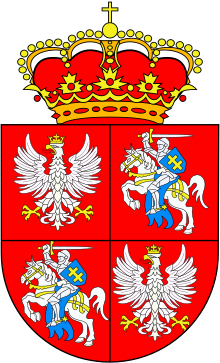Polish-Lithuanian Union
The Polish-Lithuanian Union refers to a series of legal acts and alliances between the Kingdom of Poland and the Grand Duchy of Lithuania that have existed for over 400 years since the end of the 14th century. It led to the establishment of the two-nation state Poland-Lithuania in 1569, known as Rzeczpospolita , an aristocratic republic under the " presidency " of an electoral king at the head of the state. As part of the partition of Poland at the end of the 18th century, a short-lived unitary state was created in 1791.
Internal organization of the Union
The Krewo Treaty of 1385 did not define the closer constitutional relationship between Poland and Lithuania. This led to conflicts over the distribution of power, but also over ownership of the eastern and south-eastern areas of Lithuania. The Polish-Lithuanian relationship was gradually concretized. In 1401 a grand duke was appointed governor of the king. He was able to rule relatively independently, but was obliged to be loyal to the king. In principle, he had the right to appoint the Grand Duke. In 1413 the right of the king to appoint was confirmed in the Horodło. However, this should be done in accordance with the Lithuanian nobility. It was also agreed that every new Polish king should be expressly recognized by Lithuania. In the same act of union, the Polish nobility accepted 47 Lithuanian noble families into their union. This laid the foundation for the nobility of both countries to grow together. Lithuania also resembled Poland's internal structure, so between 1504 and 1566 it was divided into voivodeships according to the Polish model .
The legal acts
The political acts were:
- 1385 Union of Krewo
- 1401 Union of Vilnius and Radom
- 1413 Union of Horodło
- 1432 Union of Grodno
- 1499 Union of Krakow and Vilnius
- 1501 Union of Mielnik
- 1569 Union of Lublin
- 1791 Constitution of May 3, 1791
Individual evidence
- ↑ cf. Andrea Schmidt-Rösler: Poland - From the Middle Ages to the Present. Verlag Friedrich-Pustet, Regensburg, 1996, p. 34
